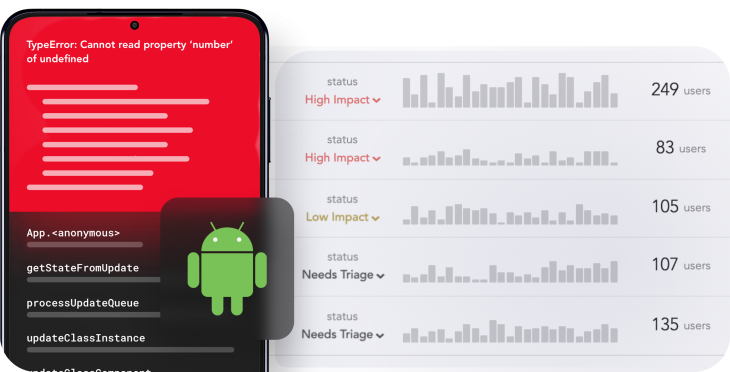
The Kotlin programming language, which was designed for a Java virtual machine (JVM), has a combination of both object-oriented and functional programming features, as well as other programming paradigms. Used in Android development, Kotlin provides a unique feature known as scope functions, however, many developers run into some difficulty when dealing with these functions.

As an Android mobile developer, it is important to have a full grasp of this concept, which is a crucial part of application development. The beauty of Kotlin comes from unique features that make it suitable for both frontend and backend development. In this tutorial, we’ll cover the following:
let functionwith functionrun functionapply functionalso functionTo follow along with this tutorial, you’ll need the following:
Let’s get started!
The Replay is a weekly newsletter for dev and engineering leaders.
Delivered once a week, it's your curated guide to the most important conversations around frontend dev, emerging AI tools, and the state of modern software.
In Kotlin, scope functions are used to execute a block of code within the scope of an object. Generally, you can use scope functions to wrap a variable or a set of logic and return an object literal as your result. Therefore, we can access these objects without their names. There are five types of scope functions in Kotlin: let, with, run, apply, and also. Let’s consider these examples and their unique use cases.
There are many similarities between these five scope functions based on their similar operations, however, they differ in whether they return a lambda result or context object. They also vary in whether you refer to the context object using the this or the it keyword.
let functionThe let function has numerous applications, but it is generally used to prevent a NullPointerException from occurring. The let function returns the lambda result and the context object is the it identifier. Let’s consider the following example:
fun main (){
val name: String? = null
println(name!!.reversed)
println(name.length)
}
In the code snippet above, we assigned a null value to the name variable. We then printed the reverse and the length of the string by including a NotNull assertion operator (!!) to assert that the value is not null because we have a nullable string name. Because we are calling the function on a null value, this results in a NullPointerException. However, we could prevent this by using the let function with the following code:
fun main (){
val name: String? = null
name?.let{
println(it.reversed)
println(it.length)
}
}
We place our code inside the lambda expression of the let function and replace the context object name with the it identifier. To prevent the NullPointerException, we include a safe call operator, ( ?.), just after our name object.
The safe call operator places a condition and instructs our program to execute the code only if the name object is NotNull. In this example, we do not need to use the NotNull assertion (!!).
Next, we’ll assign a string value “I love Kotlin” to our name variable. Then, we return this string value by saving our lambda value in a variable called lengthOfString:
fun main (){
val name: String? = "I love Kotlin!!"
val lengthOfString = name?.let{
println(it.reversed)
println(it.length)
}
println(lengthOfString)
}
with functionThe with function has a return type as the lambda result, and the context object is the this keyword, which refers to the object itself. Let’s consider the example in the code snippet below:
class Person{
var firstName: String = "Elena Wilson"
var age: Int = 28
}
fun main() {
val person = Person()
println(person.firstName)
println(person.age)
}
In the code snippet above, we created a Person class and assigned some properties, firstName and age. Next, in our main function, we printed out the values using println, which is used for cli output.
Let’s imagine that we had over twenty properties in the Person class, which would result in multiple code repetitions. We can correct this by using the with function and passing the person object in the lambda expression using the this keyword:
n){
println(this.firstName)
println(this.age)
}
The context object here refers to the person object on which the operation is performed. The return value of the with function is a lambda result. Imagine we decide to add ten years to the age and store the value in a variable called personInfo, which is of the type integer:
val person = Person()
val personInfo : String = with (person){
println(this.firstName)
println(this.age)
age + 10
"I love the game of football"
}
println(personInfo)
}
The value produced is “I love the game of football”. In summary, the with function returns a lambda function and uses the this keyword as the context object.
run functionThe run function returns the lambda result, and we refer to the context object by using the this keyword. The run function is a combination of the with and let functions. Let’s consider the example in the code snippet below:
fun main {
val person: Person? = Person()
val bio = person?.run {
println(name)
println(age)
"LogRocket rocks!!!"
}
println(bio)
}
Assuming we decide to assign a null value to the person object, we’d have to prevent a NullPointerException from occurring. We can achieve this by calling the run function with the person object. Next, we’ll return the lambda function bio.
apply functionapply is a higher order function. The apply function returns a context object, and the context object returns this. Let’s consider the following example:
val car = Car()
var carName: String = ""
var carColor: String = ""
fun main {
val car = Car().apply {
carName = "Lamborghini"
carColor = "Navy blue"
}
}
with(car){
println(carName)
println(carColor)
}
also functionThe also function is similar to the previous functions in that it is used to perform an operation on a particular object after it has been initialized. The also function returns the context object, and the context object can be referred to using the it identifier. Let’s refer to the code snippet below for further detail:
fun main(){
val numberList: mutableList<Int> = mutableListOf(1,2,4,5)
numberList.also{
println("The list of items are: $numberList")
numberList.add(6)
println("The list of items after adding an element are: $numberList")
numberList.remove(4)
println("The list of items after removing an element are: $numberList")
}
}
From the code above, we created a numbersList object with five integer values and performed some operations under the numbersList object. We then utilized the also function. Note that in the also function, we can refer to the numberList by using the it identifier, as seen in the code snippet below:
fun main(){
val numberList: mutableList<Int> = mutableListOf(1,2,4,5)
val multipleNumbers = numberList.also {
println("The list of items are: $it")
it.add(6)
println("The list of items after adding an element are: $it")
it.remove(4)
println("The list of items after removing an element are: $it")
}
println("The original numbers are: $numberList")
println("The multipleNumbers are: $multipleNumbers)
}
Another way to implement the also function is using the it and also keywords like in the code snippet below. We use the also function to modify the value of the firstName variable by assigning Eden Peter to it:
fun main {
val person = Person().apply {
firstName = "Eden Elenwoke"
age = 22
}
with(person){
println(firstName)
println(age)
}
person.also{
it.firstName = "Eden Peter"
println("My new name is: + ${it.firstName}")
}
}
Using scope functions in the right place might seem a bit tricky at first, but it largely depends on what we want to achieve with project. Let’s refer the summary below as a guide to inform us on which scope function to use for each unique use case:
apply: You want to configure or initialize an objectwith: You want to operate on a non-null objectlet: You want to execute a lambda function on a nullable object and avoid NullPointExceptionrun: You want to operate on a nullable object, execute a lambda expression, and avoid NullPointerException. This is the combination of the with and let function featuresalso: You want to perform some additional object operations and configurationsLet’s compare a scope function and a normal function with a few examples. Let’s consider a normal function using a class named Student with three attributes, studentName, studentNumber, and studentAge, like below:
Class Student {
var studentName : String? = null
var studentNumber : String? = null
var studentAge : Int? = null
}
With the code snippet below, we instantiate our class and assign values to it:
val student = Student () student.studentName = "Peter Aideloje" student.studentNumber = 08012345678 student.studentAge = 28
Using a scope function can help us to achieve the same results as above in a simpler and cleaner way with less code. Let’s compare our expression above with a scope function in the code snippet below:
val person = Student().apply{
studentName = "Peter Aideloje"
studentNumber = 08012345678
studentAge = 28
}
In the code snippet above, we instantiate the Student object and call the apply function. Then, we assign the studentName, studentNumber, and studentAge properties within the lambda expression.
When we compare the scope function and the normal function in the examples above, we notice that we successfully eliminated code repetition where the student object name was repeated multiple times. Using a scope function makes our code more concise and readable, and we initialized our properties without using the student object name.
From the examples in the function comparison section above, we have come to realize some benefits of using scope functions:
For further reading, you can also checkout the official Kotlin documentation.
In this article, we introduced the five scope functions in Kotlin. We also considered some unique use cases with examples, reviewing when to use each scope function. We compared scope functions with normal functions and finally reviewed the benefits of using scope functions.
As Android development continues to grow in popularity with more Android devices on the market, knowledge of the Kotlin programming language will become more crucial. I hope this article was helpful, and please feel free to leave a comment if you have any questions. Happy coding!
LogRocket is an Android monitoring solution that helps you reproduce issues instantly, prioritize bugs, and understand performance in your Android apps.
LogRocket's Galileo AI watches sessions for you, instantly identifying and explaining user struggles with automated monitoring of your entire product experience.
LogRocket also helps you increase conversion rates and product usage by showing you exactly how users are interacting with your app. LogRocket's product analytics features surface the reasons why users don't complete a particular flow or don't adopt a new feature.

Start proactively monitoring your Android apps — try LogRocket for free.

AG-UI is an event-driven protocol for building real AI apps. Learn how to use it with streaming, tool calls, and reusable agent logic.

Frontend frameworks are often chosen by default, not necessity. This article examines when native web APIs deliver better outcomes for users and long-term maintenance.

Valdi skips the JavaScript runtime by compiling TypeScript to native views. Learn how it compares to React Native’s new architecture and when the trade-off makes sense.

What trends will define web development in 2026? Check out the eight most important trends of the year, from AI-first development to TypeScript’s takeover.
Would you be interested in joining LogRocket's developer community?
Join LogRocket’s Content Advisory Board. You’ll help inform the type of content we create and get access to exclusive meetups, social accreditation, and swag.
Sign up now